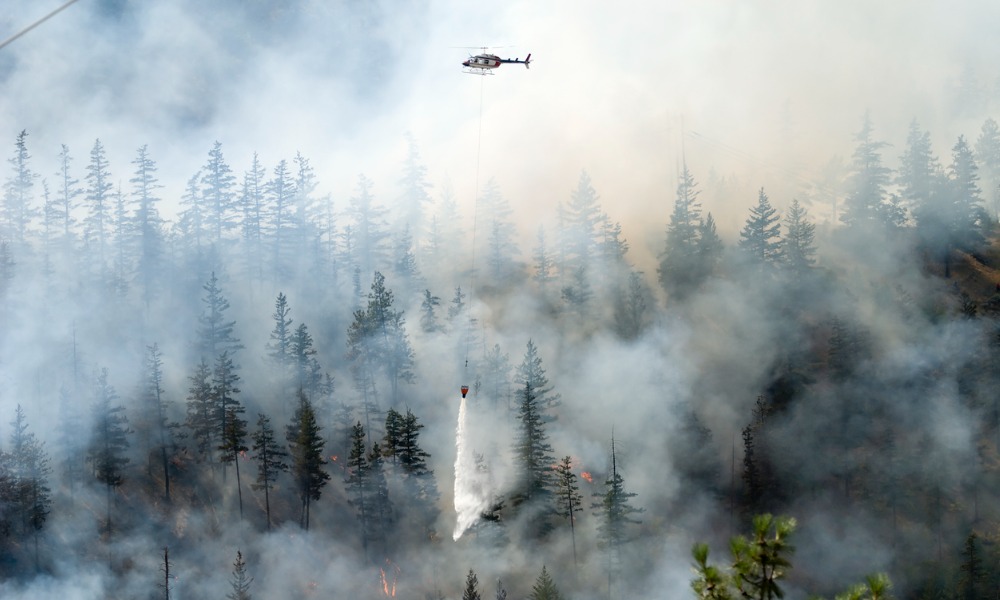Wildfires outside or contaminants inside – both are threats to workplace health and safety

Sometimes, when your job gets a little too crazy, you need to stop and take a breath. But what if taking that breath could be even more harmful?
Employer have an obligation under occupational health and safety legislation to take every reasonable precaution to protect the health and safety of their employees. And that could include the air they breathe.
Even for outside workers where the employer doesn’t have any control over the air outside, there is an obligation to limit employee exposure to bad air. While it’s not reasonable to expect any influence over the air quality outside, it is reasonable to decrease or cancel outside work, or to provide personal protective equipment if possible.
The massive spread of wildfires across Canada and North America this year have often led to large chunks of the country being engulfed in thick smoke, creating a hazardous breathing environment for anyone outside, let alone people trying to work. This issue even recently became an issue for the Canadian Football League (CFL), when its players’ association expressed concern over the fact that a game in Calgary was played while the city was shrouded with thick smoke from wildfires. This led to an agreement between the CFL and the players’ association to have a third party regularly check air quality during games and potentially halt or postpone a game if the air doesn’t meet set standards.
A professional football game is a high-profile arena for such an issue to come up, but it’s something that all employers with outdoor workers need to prepare for as part of their health and safety obligations, particularly since wildfires and increased temperatures are becoming bigger problems with climate change.
Indoor air quality
Of course, addressing air quality isn’t just something employers need to prioritize for outdoor workers. Indoor employees need to breathe good air, too, or they can develop health issues. Whether an employer owns or leases their office space, they still have to meet that legal obligation to take every reasonable step to ensure the health and safety of employees. That can mean ensuring a good HVAC system that filters and circulates the air so polluting particles and viruses are removed as much as possible.
Air quality has become a particularly important issue in the wake of the COVID-19 pandemic. Early last year, a survey in the US and Canada found that almost three-quarters of people felt nervous when entering places of poor air quality and nearly seven in 10 workers felt their workplaces needed to invest more on health, hygiene and safety, including measures such as air filtration. When employers are finding it a challenge to get remote employees back in the physical workplace, efforts to provide a healthy and hospitable working environment can go a long way.
Even if an employer has met its health and safety obligations, there could still be a need to do more if any employees have conditions such as environmental sensitivity. Back in 2007, the Canadian Human Rights Commission established environmental sensitivity as a disability protected by human rights legislation, meaning that the employer will have to make a reasonable effort to accommodate the condition to the point of undue hardship.
Accommodation options
About a decade ago, an Edmonton bus driver developed a severe environmental allergy that required medicine that made it unsafe to drive a bus. It was discovered that she could be accommodated by driving an LRT train that would limit exposure to fumes. The city properly pursued this option, but the worker resigned over the denial of disability benefits because of this accommodation option. The Alberta Human Rights Tribunal and an appeal court rejected the worker’s discrimination claim because the city met its duty to accommodate with the offer of the LRT operator position, and it was the worker who refused to participate in the accommodation process.
A similar situation happened in BC, when a worker was diagnosed with hay fever and a condition related to long-term exposure to contaminants. The employer changed ventilation at the workplace after a Workers’ Compensation Board inspection. Years later, the worker had a chemical reaction attack at work and he asked to be moved to another department. The employer asked for a doctor’s note and a functional capacity evaluation to help determined what he could do, but the worker refused and didn’t return to work. An arbitrator found that the worker abandoned his job and didn’t provide medical evidence to help find an accommodation solution.
However, more recently, an Alberta employer got itself into trouble when it was dismissive of a worker’s environmental sensitivity. It refused the worker’s requests to conduct special tests for mold levels related to a rare condition with which she had been diagnosed because the tests weren’t recognized as a health and safety standard. The province’s human rights tribunal found that the worker’s termination was discriminatory because there was no evidence the tests would negatively impact the workplace and the employer didn’t look into the possibility of performing the tests or any other form of accommodation.
Clean, breathable air is essential and fundamental to the health and safety of workers, whether they are doing their jobs outside or within the confines of an indoor work environment. In either circumstance, the employer’s health and safety obligations require them to do everything possible to ensure that every workday is a breath of fresh air.




